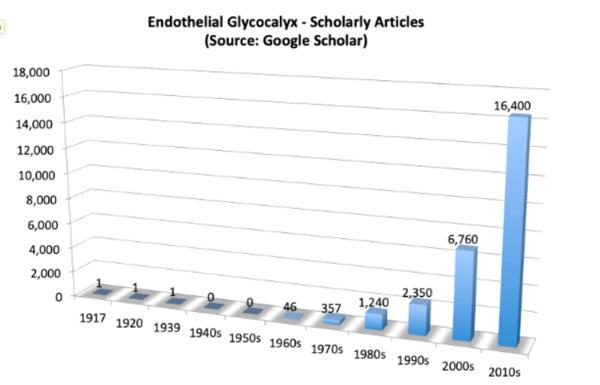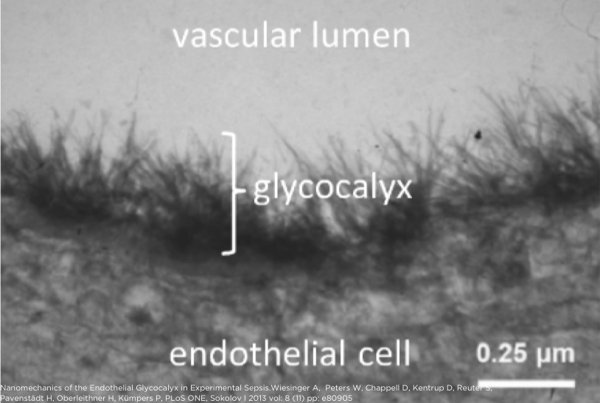
In the past decade, there has been an explosion of research into the microbiome and its effects on overall health. The notion that such a microscopic structure can have far-reaching, long-term effects on overall wellness is now widely accepted, as well as the connection between a disrupted microbiome and specific conditions.
Within the 60,000 miles of blood vessels in every human body, another structure invisible to the naked eye has similar widespread effects. The endothelial glyocalyx (EGX) is a micro-thin, gel-like lining that acts as gatekeeper, regulator, and much more for the blood vessels. The EGX is now recognized as a “novel biomarker” for vascular dysfunction.1
The EGX is currently in the midst of a similar explosion in the research (see Figure 1).

Figure 1. Over the years, research interest in the endothelial glycocalyx has dramatically increased.
Dysfunction of the EGX has been linked to myriad conditions:
- Atherosclerosis2,4
- Diabetes2,3,4
- Hypertension5,6,7
- Sepsis8,9,10
- Renal dysfunction2 and chronic kidney disease10
- Edema1,12
- Embolic stroke13
- And more.
The EGX is a micro-thin, gel-like layer that lines the interior of the endothelium. It is made up of glycans and glycoconjugates, the focus of the fast-growing field of glycobiology. Glycans play an essential role in cell-to-cell communication.
The EGX is ubiquitous throughout the cardiovascular system, including in the heart and the capillaries. Importantly, like the microbiome, the EGX is quite dynamic. The EGX is delicate and can be easily damaged, but is also resilient and can repair itself.

Figure 2. Close-up image of the glycocalyx lining the vascular lumen and protecting the endothelium.
The glycocalyx's many roles
The EGX has a number of important roles in supporting blood flow, vascular health, immune function, and mediating endothelial permeability. As one review article stated,
“[EGX] degradation is closely associated with pathophysiologic changes such as vascular permeability, edema formation, mechanotransduction, and clotting cascade, together with neutrophil and platelet adhesion in diverse injury and disease states.”3
The EGX has several properties that allow it to have such systemic impacts. In particular, it is slippery, provides a selective permeability barrier, acts as a sieve, signals the endothelium and immune system, and stores important antioxidants.
Slippery & selective barrier
One of the key aspects of the EGX is its slipperiness. Arterial walls need protection from the many cells traveling through the blood. When cells like leukocytes or platelets adhere to the arterial walls, inflammation and damage occurs.14 Cell studies have shown that an impaired glycocalyx results in an inflammatory cascade and increased leukocyte adhesion.15,16 EGX breakdown is also implicated in lipid adhesion in the blood vessels,17 a precursor for atherosclerosis.
The EGX resembles both a mesh and a gel, with a negative charge that (usually) repels leukocytes.1 This gives it the ability to act as a gatekeeper and sieve, regulating vascular permeability. This selective permeability barrier allows the right molecules and cells through the endothelium, while repelling others.
Signaling and mediating
In response to blood flow, the EGX signals the endothelium to produce nitric oxide.18 The EGX also plays a signaling role in stabilizing the vasculature, both new vasculature and maintaining existing blood vessels.19 The mechanosensing and maintenance functions of the EGX are areas of growing research interest.20
The EGX regulates the microenvironment at the endothelial surface via its anticoagulant, anti-inflammatory, and antioxidant activities. The EGX also plays a role in mediating immune and inflammatory functions.21 By regulating the microenvironment of the endothelial surface through anticoagulant, anti-inflammatory, and antioxidant activities, a healthy EGX supports a healthy immune response. When the EGX is degraded, a feed-forward cycle can occur where inflammation or damage leads to an upregulated immune response.13
Antioxidant storage
The EGX binds and harbors a variety of soluble molecules derived from both the endothelium and circulating blood. These docker molecules are important to the structural and functional properties of EGX. Among them, two proteins, namely albumin and extracellular dismutase (ecSOD), contribute significantly to the antioxidant activities of the EGX.
These antioxidants help maintain the health of the entire vascular system.
Why support the EGX?
Overall, the tiny but ubiquitous EGX is a SMART barrier:
SELECTIVE: It is a selectively permeable barrier that prevents cholesterol, platelets, leukocytes and other circulating blood components from sticking to vessel walls.
MICRO-THIN: It is micro-thin – about 1,000 EGX layers would equal the thickness of one sheet of paper.
ANTIOXIDANT: It harbors antioxidative enzyme superoxide dismutase (SOD) that reduces oxidative stress and keeps nitric oxide (NO) available in the vascular system.
REGULATOR: It regulates vascular permeability, inflammation, coagulation, and fluid balance.
TRANSDUCER: It is a signaling transducer –it senses shear stress of blood flow and sends signals to the endothelium to produce nitric oxide.
Clearly, the EGX plays an important role in vascular health. Its many functions and roles in the body suggest that supporting the EGX, and thus the endothelium and vascular system, will be increasingly important in the next few years.
Still curious? Watch this 20-minute presentation on the current science around the EGX.
References
- Liew H, Roberts MA, MacGinley R, McMahon LP. Endothelial glycocalyx in health and kidney disease: Rising star or false Dawn?. Nephrology (Carlton). 2017;22(12):940-946. doi:1111/nep.13161
- Sieve I, Münster-Kühnel AK, Hilfiker-Kleiner D. Regulation and function of endothelial glycocalyx layer in vascular diseases. Vascul Pharmacol. 2018;100:26-33. doi:1016/j.vph.2017.09.002
- Valerio L, Peters RJ, Zwinderman AH, Pinto-Sietsma SJ. Sublingual endothelial glycocalyx and atherosclerosis. A cross-sectional study. PLoS One. 2019;14(3):e0213097. Published 2019 Mar 27. doi:1371/journal.pone.0213097
- Kolářová H, Ambrůzová B, Svihálková Šindlerová L, Klinke A, Kubala L. Modulation of endothelial glycocalyx structure under inflammatory conditions. Mediators Inflamm. 2014;2014:694312. doi:1155/2014/694312
- Guo J, Yang ZC, Liu Y. Attenuating Pulmonary Hypertension by Protecting the Integrity of Glycocalyx in Rats Model of Pulmonary Artery Hypertension. Inflammation. 2019;42(6):1951-1956. doi:1007/s10753-019-01055-5
- Facchini L, Bellin A, Toro EF. Modeling Loss of Microvascular Wall Homeostasis during Glycocalyx Deterioration and Hypertension that Impacts Plasma Filtration and Solute Exchange. Curr Neurovasc Res. 2016;13(2):147-155. doi:2174/1567202613666160223121415
- Choi HY, Park HC, Ha SK. Salt Sensitivity and Hypertension: A Paradigm Shift from Kidney Malfunction to Vascular Endothelial Dysfunction. Electrolyte Blood Press. 2015;13(1):7-16. doi:5049/EBP.2015.13.1.7
- Iba T, Levy JH. Derangement of the endothelial glycocalyx in sepsis. J Thromb Haemost. 2019;17(2):283-294. doi:1111/jth.14371
- Song JW, Zullo J, Lipphardt M, et al. Endothelial glycocalyx-the battleground for complications of sepsis and kidney injury. Nephrol Dial Transplant. 2018;33(2):203-211. doi:1093/ndt/gfx076
- Martin L, Koczera P, Zechendorf E, Schuerholz T. The Endothelial Glycocalyx: New Diagnostic and Therapeutic Approaches in Sepsis. Biomed Res Int. 2016;2016:3758278. doi:1155/2016/3758278
- Padberg JS, Wiesinger A, di Marco GS, et al. Damage of the endothelial glycocalyx in chronic kidney disease. Atherosclerosis. 2014;234(2):335-343. doi:1016/j.atherosclerosis.2014.03.016
- Cao RN, Tang L, Xia ZY, Xia R. Endothelial glycocalyx as a potential theriapeutic target in organ injuries. Chin Med J (Engl). 2019;132(8):963-975. doi:1097/CM9.0000000000000177
- Ikonomidis I, Frogoudaki A, Vrettou AR, et al. Impaired Arterial Elastic Properties and Endothelial Glycocalyx in Patients with Embolic Stroke of Undetermined Source. Thromb Haemost. 2019;119(11):1860-1868. doi:1055/s-0039-1694752
- Swirski FK, Nahrendorf M. Leukocyte behavior in atherosclerosis, myocardial infarction, and heart failure. Science. 2013;339(6116):161-166. doi:1126/science.1230719
- McDonald KK, Cooper S, Danielzak L, Leask RL. Glycocalyx Degradation Induces a Proinflammatory Phenotype and Increased Leukocyte Adhesion in Cultured Endothelial Cells under Flow. PLoS One. 2016;11(12):e0167576. Published 2016 Dec 1. doi:1371/journal.pone.0167576
- Lipowsky HH. The endothelial glycocalyx as a barrier to leukocyte adhesion and its mediation by extracellular proteases. Ann Biomed Eng. 2012;40(4):840-848. doi:1007/s10439-011-0427-x
- Mitra R, O'Neil GL, Harding IC, Cheng MJ, Mensah SA, Ebong EE. Glycocalyx in Atherosclerosis-Relevant Endothelium Function and as a Therapeutic Target. Curr Atheroscler Rep. 2017;19(12):63. Published 2017 Nov 10. doi:1007/s11883-017-0691-9
- Bartosch AMW, Mathews R, Tarbell JM. Endothelial Glycocalyx-Mediated Nitric Oxide Production in Response to Selective AFM Pulling. Biophys J. 2017;113(1):101-108. doi:1016/j.bpj.2017.05.033
- Zeng Y. Endothelial glycocalyx as a critical signalling platform integrating the extracellular haemodynamic forces and chemical signalling. J Cell Mol Med. 2017;21(8):1457-1462. doi:1111/jcmm.13081
- Zeng Y, Zhang XF, Fu BM, Tarbell JM. The Role of Endothelial Surface Glycocalyx in Mechanosensing and Transduction. Adv Exp Med Biol. 2018;1097:1-27. doi:1007/978-3-319-96445-4_1
- Cahill PA, Redmond EM. Vascular endothelium - Gatekeeper of vessel health. Atherosclerosis. 2016;248:97-109. doi:1016/j.atherosclerosis.2016.03.007
IMPORTANT NOTICE:
The information on this webpage is for licensed healthcare practitioner education only, and is not to be disseminated to the general public.



